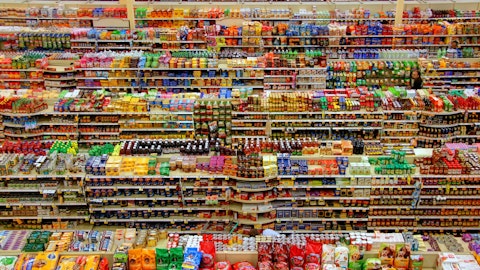Howard Coker: So Mark, I’d say just direct to your question, we have contractual obligations that are aligned to certain indices, and we’re going to have to live by those. I think maybe where you’re going is a longer-term question, and that’s something that we’re taking into consideration. But what do you do? If it doesn’t happen, we pull the contingency plans that we’ve got in place to make up for the difference. But you noted exactly right that the uptake from our open market was highly successful. We are running here in North America with backlogs that I just noted a minute ago that we haven’t seen in literally in years. And that is as far as we can see out, let’s just say, in the third quarter. So, I would be shocked if any index didn’t reflect those type of market conditions, but I think maybe you’re asking a longer-term question and that’s one that we’re certainly considering at this point here as well.
Mark Weintraub: That’s very helpful. And maybe now with the RTS transaction done as well, could you remind us sensitivities for every $10 per ton change, let’s just say in the index, how it impacts the North American market, how it would flow through to EBITDA?
Howard Coker: Yes. Each $10 move in Tan Bending Chip is about $5 million a year, up or down.
Mark Weintraub: I’m sorry, I don’t maybe I’m asking the wrong question. But don’t you have north of one million tons of.
Rodger Fuller: Yes. We have 1.2 million tons in North America. But remember, almost 40% of that does not move off the index.
Mark Weintraub: Got it. Okay.
Rodger Fuller: It’s either open market and some OCC movement.
Mark Weintraub: Okay, super. That is helpful. And just maybe real quickly to you noted that OCC you thought would be higher 2Q than 1Q I believe, yet it had shown signs of moderating in April. Is that just a carryover from 1Q having been rising as it progressed? Or is that that you’re expecting OCC to start ticking higher again?
Rodger Fuller: Some carryover, and we have projected another $5 move in the quarter as you get to the end of the quarter.
Mark Weintraub: Okay, super. Thanks for the color.
Operator: Our next question will come in from Gabe Hajde of Wells Fargo. Your line is open, Gabe.
Gabe Hajde: Good morning. Thanks for taking the question. I wanted to ask about the food can business. We’re reading more reports about imported full cans of vegetables and fruits, hitting shelves, maybe to circumvent templates, deal tariffs and otherwise. I think that’s roughly 40% of your food can mix. I’m curious, based on conversations with customers and I know they have to kind of plan for this stuff in terms of plantings, what the expectation is for the upcoming pack season that’s embedded in the food can business?
Howard Coker: Yes, Gabe, I really don’t have that level of detail. I heard the same thing in terms of imports. I don’t think we’re hearing that as a direct impact to our customers. And as we said earlier, we expect to see a slight improvement in the second quarter, and that’s feedback from our customers. So at this point in time, I really can’t speak to any type of material influence that we are aware of within our customer base related to templates materials. Certainly, it’s out there.
Gabe Hajde: Okay. Thank you. That was it for me.
Operator: [Operator Instructions]. Our next question will be coming from Gregory Andreopoulos of Citi. Your line is open.
Gregory Andreopoulos: Hi, good morning. Just a few quick questions from me on consumer price costs. So you mentioned CPGs are kind of stepping up promotions or that could be happening in the near term. So I’m wondering how you think about your or the dynamic of CPGs stepping up promotions, versus your ability to capture positive pricing in consumer or even positive price cost depending on how you want to address it? And then I had one follow-up after that.
Rodger Fuller: Yes. I mean, I think that we definitely have seen pricing dynamics at the consumer level. We think that our customers are being really dynamic in their response to kind of higher prices on the shelf and are acting appropriately to drive the right volume for them. From in terms of our price, how we see that, there are a number of index-based prices that affect that. I think overall, we’ve got kind of a little bit of price pressure, so I would say low single digit price pressure going into the second quarter. And I think that some of that is going to be metal, probably a little bit more offset, but overall, modest pricing pressure going into the second quarter from a sequential basis and then also on a year-over-year basis.
Gregory Andreopoulos: Okay. That’s fair. And, I mean, price cost didn’t seem as bad as it could have been in 1Q, but down 9%. And I think you mentioned last quarter that you had some contracts resetting lower. So I’m wondering if you could kind of address what kind of kept price cost relatively close to neutral? And then if you could remind us what was what’s implied for the full year guide in terms of consumer price cost for the balance of the year? Thank you. And I’ll turn it over after that.




